Every musician starts somewhere and choosing the right instrument is one of the most important first steps. Whether you’re looking for a guitar to play at home, jam around the campfire, or become the next Jimi Hendrix, you’ve come to the right place. This article will show you how to navigate the many factors involved in purchasing an acoustic guitar, as well as guide you to a perfect choice that fits your budget.
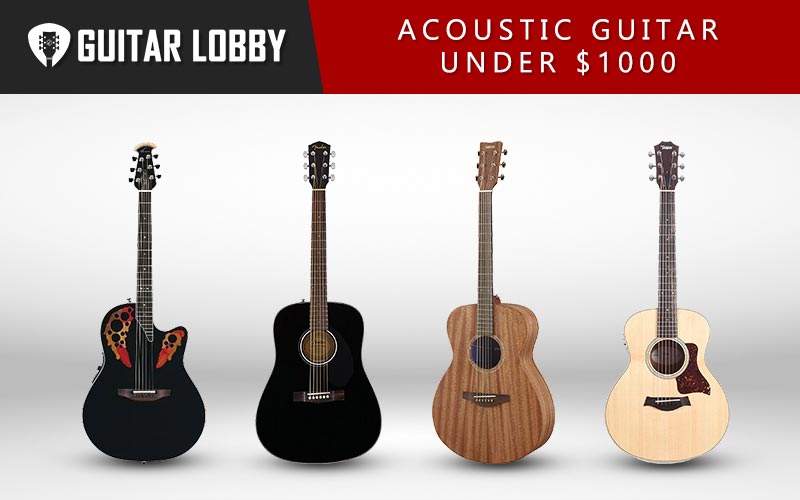
Doing some proper research about the guitars in your price range before you decide which to buy will likely lead to both a better playing experience and longevity to playing itself. I’ll start this article by jumping straight into reviews and helping you find the best acoustic guitar under 1000 dollars for your use cases, but if you want to learn more about what to look for before reading reviews, we put together an acoustic guitar buying guide at the bottom of the page.
| Name of Product | Image of Product | Description | Price Range | Full Review |
|---|---|---|---|---|
| 1. Ovation Standard Elite 2778AX (Best Overall) | 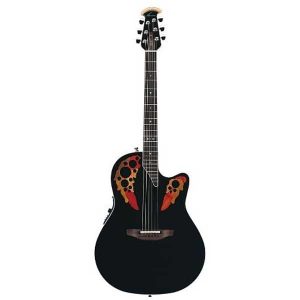 | Color: Black Number of Strings: 6 | $960 | Read Full Review Below |
| 2. PRS Paul Reed Smith SE Angelus A55E (Editor’s Choice) | 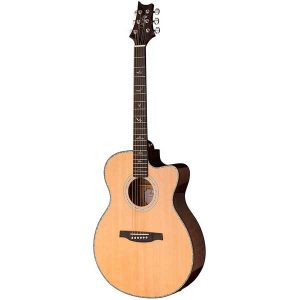 | Color: Natural Top with Black Gold Back Number of Strings: 6 | $930 | Read Full Review Below |
| 3. Taylor GS Mini-e Rosewood ES-B (Best Value) | 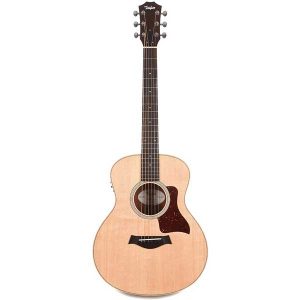 | Color: Natural Number of Strings: 6 | $700 | Read Full Review Below |
| 4. Yamaha Storia 2 (Budget Pick) | 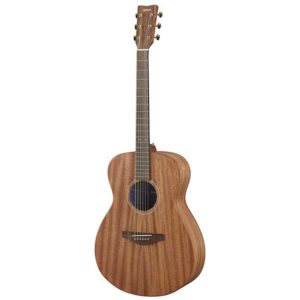 | Color: Natural Number of Strings: 6 | $430 | Read Full Review Below |
| 5. Fender PM-TE Travel Standard | 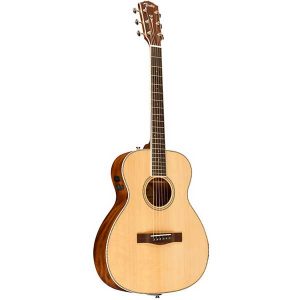 | Color: Natural Number of Strings: 6 | $840 | Read Full Review Below |
| 6. Fender PM-1E Limited Edition Paramount Series | 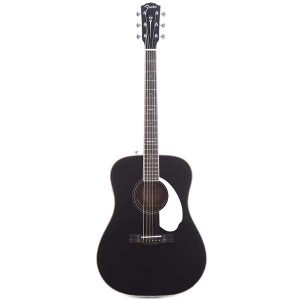 | Color: Black Number of Strings: 6 | $830 | Read Full Review Below |
| 7. Taylor GS Mini-e Quilted Sapele Limited Edition Acoustic-Electric Natural | 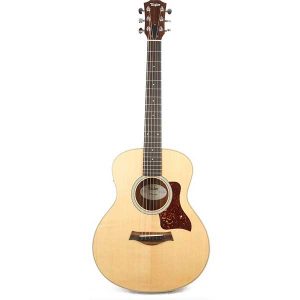 | Color: Natural Number of Strings: 6 | $800 | Read Full Review Below |
| 8. Blueridge Guitars 6 String Acoustic Guitar | 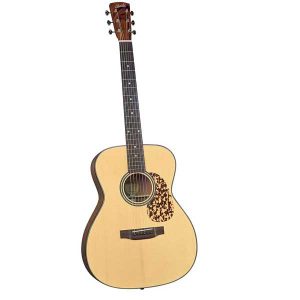 | Color: Natural Number of Strings: 6 | $800 | Read Full Review Below |
| 9. Taylor GS Mini-e Solid Koa Top | 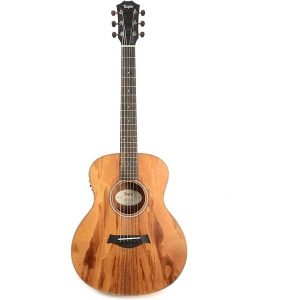 | Color: Natural Number of Strings: 6 | $800 | Read Full Review Below |
| 10. KLOS Black Carbon Fiber Travel Acoustic Guitar | 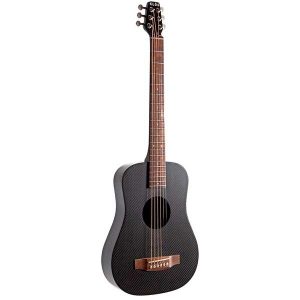 | Color: Black Number of Strings: 6 | $765 | Read Full Review Below |
| 11. Taylor GS Mini-e Limited Black Limba ESB | 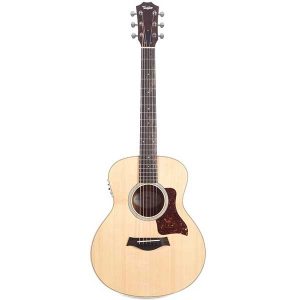 | Color: Natural Number of Strings: 6 | $750 | Read Full Review Below |
| 12. Fender 6 String Acoustic-Electric Guitar | 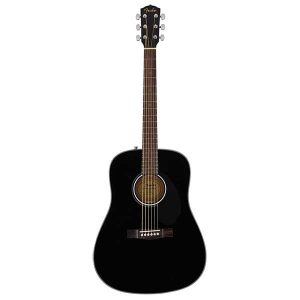 | Color: Black Number of Strings: 6 | #730 | Read Full Review Below |
| 13. Taylor Academy Series Academy 12e-N Grand Concert Nylon Acoustic Guitar Natural | 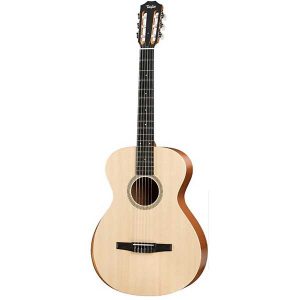 | Color: Natural Number of Strings: 6 | $700 | Read Full Review Below |
| 14. Martin Dreadnought Junior Acoustic Guitar | 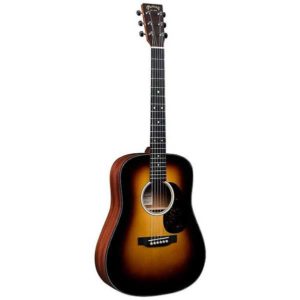 | Color: Natural Number of Strings: 6 | $500 | Read Full Review Below |
| 15. Taylor GS Mini Mahogany | 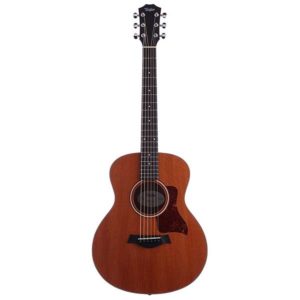 | Color: Natural Number of Strings: 6 | $500 | Read Full Review Below |
| 16. Martin LX1E Little Martin | 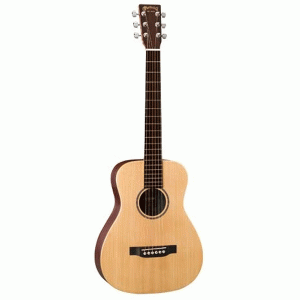 | Color: Natural Number of Strings: 6 | $450 | Read Full Review Below |
| 17. Yamaha CSF1M | 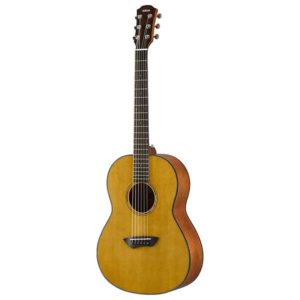 | Color: Natural Number of Strings: 6 | $430 | Read Full Review Below |
Here Are the Best Acoustic Guitars Under $1000
1. Ovation Standard Elite 2778AX (Best Overall)
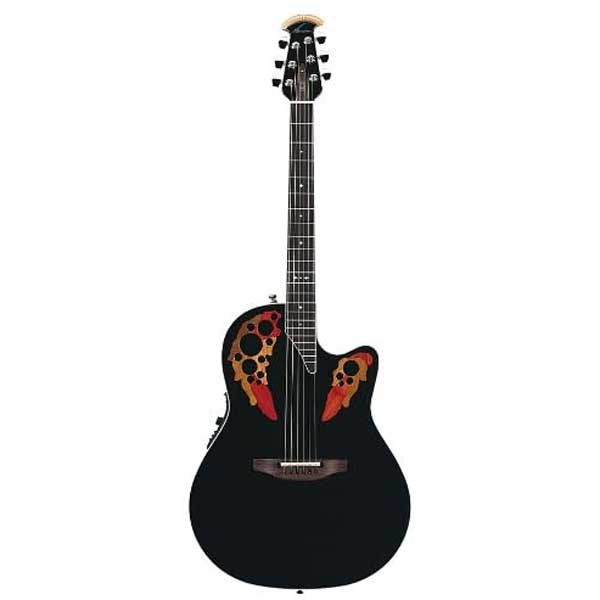
| Estimated Price | $960 |
| Body Type | Deep Contour |
| Topwood Material | AA Solid Spruce |
| Back and Sides Material | Solid-wood |
| Neck Material | Mahogany |
| Fretboard Material | Rosewood |
| Color | Black |
| Number of Strings | 6 |
My Review: The Ovation Standard Elite 2778AX Acoustic-electric Guitar has a deep acoustic sound and is known for its high-performance quality. With a deep contour body style and AA grade solid spruce top, this guitar delivers a crisp tone nuanced with clarity and precision. Other unique features to this model include inlaid exotic hardwoods and quality electronics for amplification, you can’t go wrong purchasing this instrument. It is also aesthetically pleasing with a rich and beautiful black finish. For any guitar player invested in regularly practicing and performing, this may be the guitar for you.
Key Specs and Features: This guitar has a deep contour body style that widens the waist and expands the lower bouts. This makes the soundboard much larger and thereby a more resonant sound as you play. This design is accompanied by a AA solid spruce top wood and lyrachord back that gives your sound the detailed and nuanced delivery that it deserves, paying attention to articulation and dynamic contrast. The mahogany neck material rests comfortably in the palm of your hand while you shred on the rosewood fretboard. The rosewood material gives players more autonomy with their finger movement allowing for fluid motion along the fretboard. Additionally, there are inlaid exotic hardwoods that make the look of this instrument a sight to see. The pickup is an Ovation OCP-1K that will allow you to amplify your sound with simplicity. The case for this model is sold separately.
Who Will Use the Most: Any guitarist looking to regularly perform at a high-level should consider this guitar. It really delivers exquisite playability and the ability to fill a room. The built-in electronics are of excellent quality and will sound great through a PA system.
The Bottom Line: It’s sleek, playable, and performance-ready both due to its quality of sound and comfortable feel. Overall, I would say that this is the best acoustic guitar under 1000 dollars.
2. PRS Paul Reed Smith SE Angelus A55E (Editor’s Choice)
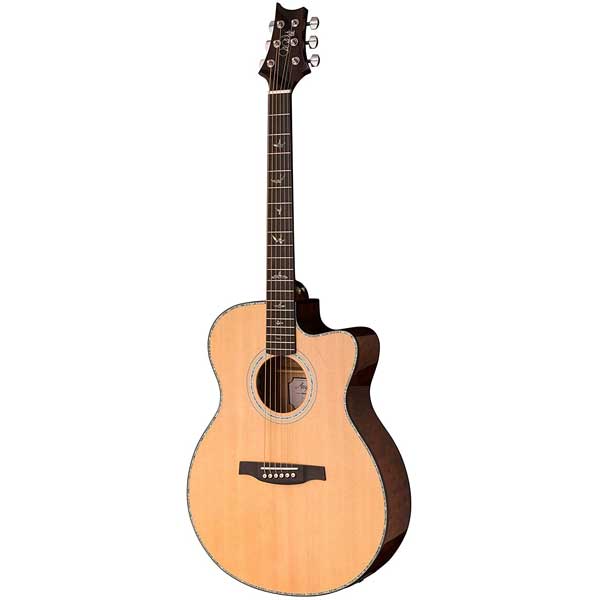
| Estimated Price | $930 |
| Body Type | Angelus Cutaway |
| Topwood Material | Solid Sitka Spruce |
| Back and Sides Material | Quilted Maple |
| Neck Material | Mahogany |
| Fretboard Material | Ebony |
| Color | Natural Top with Black Gold Back |
| Number of Strings | 6 |
My Review: The PRS Paul Reed Smith SE Angelus A55E Acoustic-Electric Guitar delivers a combination of quality sound and simplified design. The solid Sitka spruce top provides very specific nuance and clarity to your tone, which is accompanied by the quilted maple back and sides. This contributes a warm, savory quality to the rest of the sound. With a Fishman pickup system, be prepared for performances that electrify the audience with your exquisite playing filling the room. The color of the instrument will make anyone stare because of its natural top and contrasting black gold back. For any guitar player invested in one of the highest quality sounds while also providing the easiest playability, this may be the guitar for you.
Key Specs and Features: The rounded, spacious design of the guitar’s body style complements its gorgeous Angelus cutaway. This gives players the opportunity to expand their range and utilize the full scope of their fretboard. The solid Sitka spruce top combined with the quilted maple back and sides deliver a warm, resonant tone destined for live performances. The Hybrid Classical X-Bracing and white/black binding with abalone purfling give your sound a controlled and balanced tone. Your audiences will also appreciate the aesthetically pleasing gloss finish as your guitar shimmers in the light. The wide flat mahogany design of the neck provides plenty of control as you play. On the other side, the ebony fretboard allows players to comfortably shift across all 20 of its frets. The Fishman GT1 Preamp with Undersaddle Pickup gives you the option to heighten your sound and perform at larger music gigs. Included with this product is a hardshell guitar case that will make traveling to these gigs a simple and easy experience.
Who Will Use the Most: This guitar suits players looking to frequently perform in large spaces. Because of its resonant sound, but additionally, because of its electric properties, this instrument was designed for bigger venues.
The Bottom Line: Though there are less expensive guitars, this is still one of my all-time favorites in this price range.
3. Taylor GS Mini-e Rosewood ES-B (Best Value)
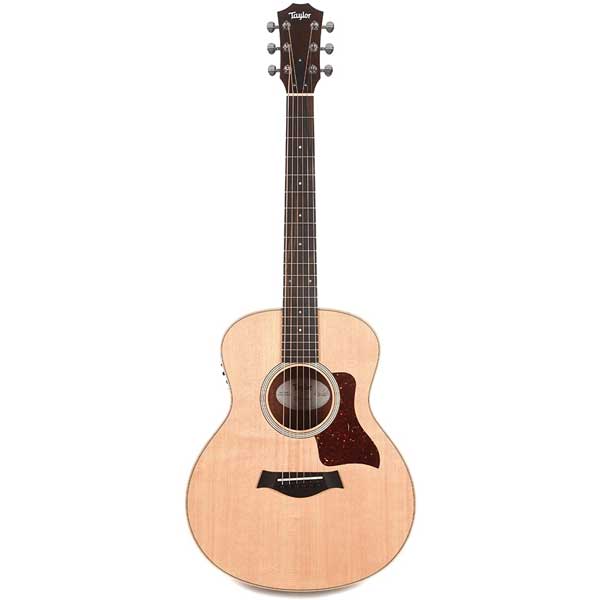
| Estimated Price | $700 |
| Weight | 8 pounds |
| Topwood Material | Spruce Wood |
| Back and Sides Material | Rosewood Laminate |
| Body Material | Rosewood Laminate |
| Fretboard Material | Ebony |
| Color | Natural |
| Number of Strings | 6 |
My Review: The Taylor GS Mini-e Rosewood ES-B delivers a quality sound with a scaled-down size perfect for anyone who enjoys playing on more compact models. The smaller Grand Symphony body provides an intelligent design with its prominent curves while simultaneously having the space for a resonant sound that will carry across the room. The clean, crisp sound comes as a result of its Sitka spruce top wood and its accompanying layered rosewood back and sides. With an easily playable neck at 23-½ inches, the Sapele wood is partnered with an ebony fretboard. This makes going from one fret to the next a breeze. This guitar also comes with an exquisite Taylor GS Mini hard bag ensuring protection as you bring your precious instrument on the road. For experienced guitar players looking for an upgrade, this may be the guitar for you.
Key Specs and Features: The Grand Symphony body style delivers a rich and robust sound that can fill any room. This style is known for its piano-like bass, strong midrange, as well as its thick trebles. There’s a strong volume while strumming while additionally supplying responsive clarity with a light attack. Combined with the spaciousness of the Grand Symphony shape is the deliciously sounding Sitka spruce top wood. Standard for many acoustic guitars, this wood helps produce a clean and crisp sound that further bolsters the clarity of your playing. The back and sides are made from a layered laminate rosewood that sits comfortably in your lap as you play. The neck is made from Sapele while the fretboard is made of smooth ebony. This allows players to have accessible mobility while moving across the fretboard, especially during solos. This model additionally has built-in Taylor Expression System 2 Electronics, which gives you further autonomy over your sound.
Who Will Use the Most: Great for playing of all ages and skill levels. This guitar is a top-quality instrument for an incredible price. At this value, this is a purchase you will not regret. Its also very travel friendly and will serve you well for practicing at home, campfires, performances, casual gigs, studio work, and everything in between.
The Bottom Line: The bottom line is that this guitar provides incredible quality at a price that’s hard to ignore. If you’re looking for the best acoustic guitar under 1000 dollars this should be a top contender because of its versatility and quality.
Popular Related Article: 14 Best American Made Guitars (Acoustic and Electric)
4. Yamaha Storia 2 (Budget Pick)
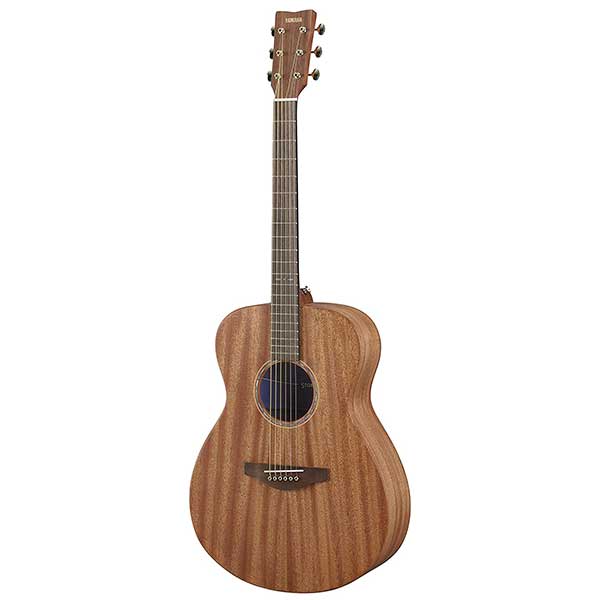
| Estimated Price | $430 |
| Body Type | Dreadnought |
| Topwood Material | Solid Mahogany |
| Back and Sides Material | Solid Mahogany |
| Neck Material | Nato |
| Fretboard Material | Rosewood |
| Color | Natural |
| Number of Strings | 6 |
My Review: The Yamaha Storia Series comes in versions 1, 2, and 3. These acoustic guitars are marketed as a series of instruments intended to make it easy for players to step up to a new guitar as their playing improves and matures. It’s a unique approach that is transparently a bit of a marketing gimmick, but the proof is in the sound and playability, so they are worth a look and worth considering. The Yamaha Storia Series are well-designed (nothing fancy) plug n’ play guitars that are comfortable and easy enough to carry back and forth from lessons to home. It is apparent that Yamaha has anticipated many things new guitar players (and their parents) may not know.
Key Specs and Features: All Storia models are solid Mahogany Concert-style bodies with a semi-gloss finish. The Storia 2, however, has a one-of-a-kind ultramarine interior color and abalone/ivory rosette inlay. The neck is easy to grip for young players, slim and constructed of Walnut. There are 20 frets and the string height is comfortably set adjacent to the hand-rolled fingerboard edges.
Who Will Use the Most: It is best suited for beginners and is an obvious choice for busy parents of new players. Offering the guitars as a step-up series also takes the guessing out of what you might be seeking in your next guitar, and what you might expect to pay.
The Bottom Line: You get affordability, simplicity, and an all-around quality-built guitar with a reputation for robust midranges and warm, vibrant tones. This is one of the best guitars under 1000 dollars out there, period.
5. Fender PM-TE Travel Standard Acoustic-Electric Guitar
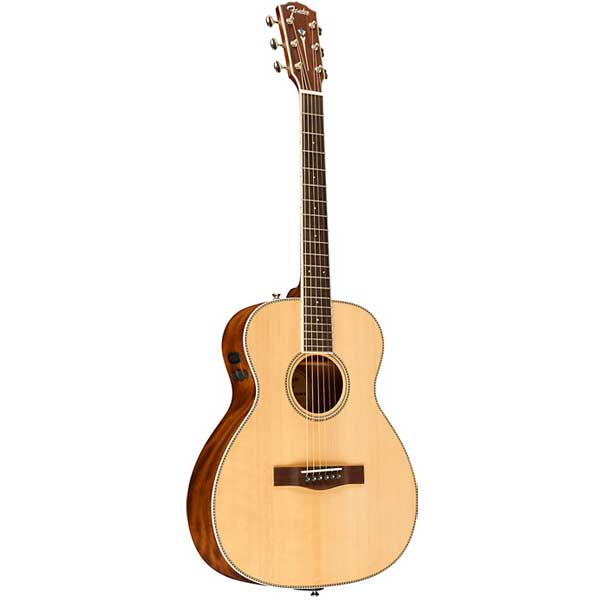
| Estimated Price | $840 |
| Body Type | Travel |
| Topwood Material | Solid Sitka Spruce |
| Back and Sides Material | Solid Mahogany |
| Neck Material | Mahogany |
| Fretboard Material | Ovangkol |
| Color | Natural |
| Number of Strings | 6 |
My Review: The Fender PM-TE Travel Standard Acoustic-Electric Guitar will serve anyone looking for a compact instrument that’s very portable. Its short scale design makes it smaller than other guitars, but don’t worry about sacrificing the quality in sound. The combination of its solid Sitka spruce top and robust mahogany back and sides deliver a crisp tone that contains high resonance as you play. With an all-solid wood construction and a beautiful natural finish, this guitar delivers a well-rounded sound that embellishes your high range while maintaining deep, resonant bass notes. Additionally, this model is acoustic-electric allowing players to plug and amplify their sound for larger venues. Make travel a breeze with the included hardshell gig bag, protecting your instrument from any unwanted damage. For players invested in practicing regularly, but also beginning their talents on the road, this may be the guitar for you.
Key Specs and Features: The compact size of this guitar comes from its travel body style, but do not be deceived by its small frame. The tone quality packs a punch from the solid Sitka spruce top and solid mahogany back and sides. Furthermore, the quartersawn scalloped X bracing pattern providing stability and a balanced sound. With a comfortable scale length of 23.5 inches, the neck easily rests in the palm of your hand. The neck is a slim mahogany material with an open pore finish. On the other side, the ovangkol fretboard gives players a sleek and simplified experience moving along its 20 frets. As mentioned before, this is an acoustic-electric guitar, allowing players to further amplify their sound. Specifically, this model has a Fender- and Fishman-Designed PM Preamp System giving players the ability to modify their volume in the way they see fit. The headstock has a typical three in-line tuners that are made of a nickel open back. The additional deluxe hardshell case is one of the best ways to protect your guitar from potential risks for damage as you travel.
Who Will Use the Most: Guitar players who enjoy travel and love performing will benefit most from this compact, portable guitar. It is certainly an on-the-go instrument.
The Bottom Line: This is a high-quality instrument that serves freelance musicians very well. It’s simple, yet sophisticated, but most importantly a guitar that is known for its utility.
Popular Related Article: Roundup of Our Favorite Acoustic Bass Guitars
6. Fender PM-1E Limited Edition Paramount Series
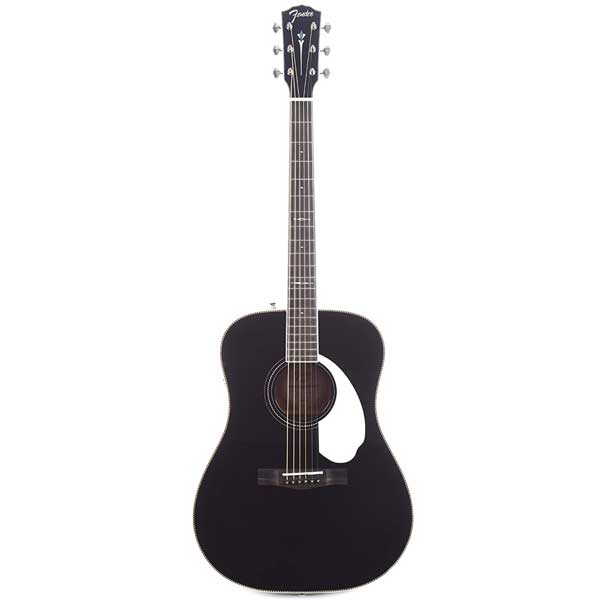
| Estimated Price | $830 |
| Body Type | Dreadnought |
| Topwood Material | Solid Sitka Spruce |
| Back and Sides Material | Solid Mahogany |
| Neck Material | Mahogany |
| Fretboard Material | Ebony |
| Color | Black |
| Number of Strings | 6 |
My Review: The Fender PM-1E Limited Edition Paramount Series Dreadnought delivers an unparalleled sound that harkens back to classic ‘60s models due to its unique all-solid wood design. With a Solid Sitka Spruce top and Solid Mahogany back and sides, this guitar produces a crisp, clear tone that will resonate well for any upcoming gig. The acoustic-electric nature of the instrument allows players to adjust controls such as Volume, Bass, Treble, with Tuner and Phase Controls when plugged into an amplifier. Other unique features include the Modified Fender Traditional Bridge as well as a Factory-Mounted Forward Strap Button with Internal Block. With a sophisticated black as its color, this guitar will make other musicians jealous because of its unique aesthetic qualities. Any guitar player looking to upgrade to a sleek new design glorifying the retrograde sound of music legends such as Bob Dylan, you may consider this as your top choice.
Key Specs and Features: The spacious dreadnought design provides relatively large, rounded bouts that boost the resonance of the overall tone. Combined with the Solid Sitka Spruce top with Solid Mahogany back and sides, the sound will be crisp, clean, and provide enough clarity to pick up subtle nuances throughout every performance. The body is finished in a lovely High Gloss that shimmers as you play. The neck offers a smooth, “C”-shape design accompanied by mahogany wood and gloss urethane finish. These qualities relay a very comfortable feel in the palm of the guitarist’s hand. The fretboard has 20 frets, which players can easily slide to and from due to the sleek and sophisticated ebony wood used. The headstock uses three in-line nickel tuners on either side that contain aged black buttons.
Who Will Use the Most: This is a wonderful guitar for a beginner looking for a great guitar or an experienced musician looking to upgrade from a previous instrument. This guitar will especially serve guitar enthusiasts after that unique sound of the 1960s.
The Bottom Line: This guitar sounds great with its all-solid top wood and back and sides. It brings affordability, versatility, and portability to the forefront.
7. Taylor GS Mini-e Quilted Sapele Limited Edition Acoustic-Electric

| Estimated Price | $800 |
| Body Type | Miniature Grand Symphony |
| Topwood Material | Sapele |
| Back and Sides Material | Sapele laminate |
| Neck Material | Mahogany |
| Fretboard Material | Ebony |
| Color | Natural |
| Number of Strings | 6 |
My Review: The Taylor GS Mini-e Quilted Sapele Limited Edition Acoustic-Electric delivers a big sound through its compact size. With a scale length of 23.5 inches and a weight of only three pounds, this lightweight instrument provides players with a comfortable, simplified feel desired by experienced guitarists. Genuinely-crafted in Mexico, the Sapele top wood goes well with the satin-finished quilted Sapele laminate back and sides to create a clear and resonant tone. Along with the quality you will receive from the guitar, this product also comes with its very own gig bag, making traveling to gigs as simple as pie. This is the standard for any guitar player devoted to their craft, either buying a guitar for the first time or interested in upgrading the instrument they currently have.
Key Specs and Features: The Grand Symphony body style of this guitar contributes to its girthy lower midrange and strong treble shimmer due to a skinnier waist and wider lower bouts. Both the top wood as well as the back and sides of the instrument are made of a Sapele, giving the tone a crisp, clean output. The mahogany soft V-neck design allows players more control when playing. Most players that prefer a V-neck also like to hang their thumb over the back of the neck and partially onto the fretboard. The fretboard itself has an ebony wood material that allows players to comfortably shift back and forth between any of the 20 frets. The headstock has a standard three in-line tuners on either side which makes adjusting each string a breeze. This guitar also comes with its very own portable gig bag. Whether going to the local open mic or road-tripping across the country, this accessory will protect your instrument from any potential damage it may endure.
Who Will Use the Most: Seeing this guitar as standard for any serious guitar player, any serious beginner or experienced guitar player should consider this instrument. For the quality of Sapele top wood at such a reasonable price, this product is a steal.
The Bottom Line: This is a high-value guitar that works perfectly for any musician looking to start playing or upgrade to a better guitar.
Related Popular Article: Review of Our Favorite Beginner Acoustic Guitars
8. Blueridge Guitars 6 String Acoustic Guitar
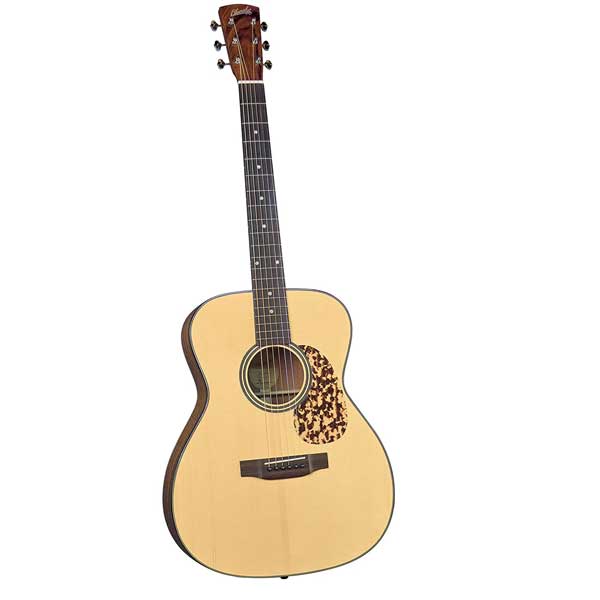
| Estimated Price | $800 |
| Body Type | Dreadnought |
| Topwood Material | Premium Solid Adirondack Spruce |
| Back and Sides Material | Select Mahogany |
| Neck Material | Mahogany |
| Fretboard Material | Santos Rosewood |
| Finish | Sunburst High Gloss |
| Number of Strings | 6 |
My Review: The Blueridge Guitars 6 String Acoustic Guitar brings something new to the market with its unique tonewood and excellent prewar tone. Its exquisite sound comes from the beautiful combination of the solid Adirondack spruce top and precise scalloped braces. The guitar has a Sunburst High Gloss finish that shimmers and reflects light as you play. Additionally, this product comes with its very own specially designed Blueridge BV-1012 Pro Tour Deluxe Dreadnought Guitar Gig Bag. For a serious student that values this guitar’s rare tonewood for an absolute bargain, you may consider purchasing this one.
Key Specs and Features: The dreadnought body style compliments the premium (and very rare) solid Adirondack spruce top in creating a spacious, prewar tone. The back, sides, and neck are made of mahogany, which glimmer as a result of the gorgeous Sunburst High Gloss finish. This tonewood will provide a robust sound that delivers high resonance while playing. The neck’s durability increases the longevity of the instrument and decreases the likelihood of cracks in the future. The Santos Rosewood fretboard allows guitarists to easily move from fret to fret and chord to chord. This guitar’s headstock has a standard three in-line tuner set up for each side, giving players the ability to adjust their strings as necessary. Included in this purchase comes the soft and portable Blueridge BV-1012 Pro Tour Deluxe Dreadnought Guitar Gig Bag. With this provided accessory, traveling from gig to gig will become a breeze. The case will prevent any potential that the guitar may endure in the process of getting to the next place.
Who Will Use the Most: For guitar students serious about their craft, but also those who don’t want to break the bank, this Blueridge may serve you well. This is especially true for guitar enthusiasts devoted to the more traditional prewar sound.
The Bottom Line: There are cheaper guitars out there, for its rare top wood, you will not find a better price. This is a high-value purchase that you will not regret.
9. Taylor GS Mini-e
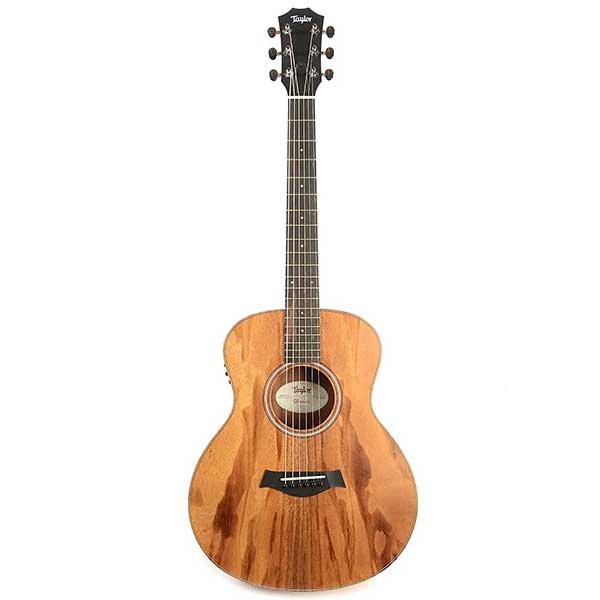
| Estimated Price | $800 |
| Body Type | Miniature Grand Symphony |
| Topwood Material | Hawaiian Koa |
| Back and Sides Material | Hawaiian Koa |
| Neck Material | Mahogany |
| Fretboard Material | Ebony |
| Color | Natural |
| Number of Strings | 6 |
My Review: The Taylor GS Mini-e Solid Koa delivers a deep and vibrant sound as a result of its Hawaiian top wood and spacious Grand Symphony body type. Don’t be deceived by the “Mini” aspect of this guitar. With a lightweight design coming in at only 4.4 pounds, this instrument packs punch and will have carrying sound in any room. You will also love the aesthetically pleasing “natural” coloring that contains many different shades of brown embedded on the surface of the body.
Whether you’re a beginner or experienced guitar player looking for an upgrade, you may want to consider this one.
Key Specs and Features: The miniature design of this Grand Symphony guitar makes it portable and easily carried to local gigs. A smaller-scale length of 23.5 inches further makes it easier to bring places. Once there, your fans will be amazed by its boisterous sound conceived from the solid Koa top wood, known for producing spectacular midrange notes with absolute clarity. The back and sides are also made of solid Koa as this is common when using this luxury wood. The mahogany neck will comfortably sit in the palm of your hand as you move along the ebony fretboard. This wood will make it simple to move from one fret to another. The headstock has a traditional three in-line tuners on either side that allow players to adjust the pitches of their strings with ease. This product also comes with a convenient gig bag, making transport both easier and safer, protecting your instrument from any unwanted damage.
Who Will Use the Most: Because of its luxury Koa wood, this guitar will work great for more experienced guitar players looking to upgrade for something more comfortable to play.
The Bottom Line: Though this guitar is more expensive than other guitars, you will receive top-quality both in sound and playability.
Related Article: Cheap Acoustic Guitars that Still Sound Great
10. KLOS Black Carbon Fiber Travel Acoustic Guitar
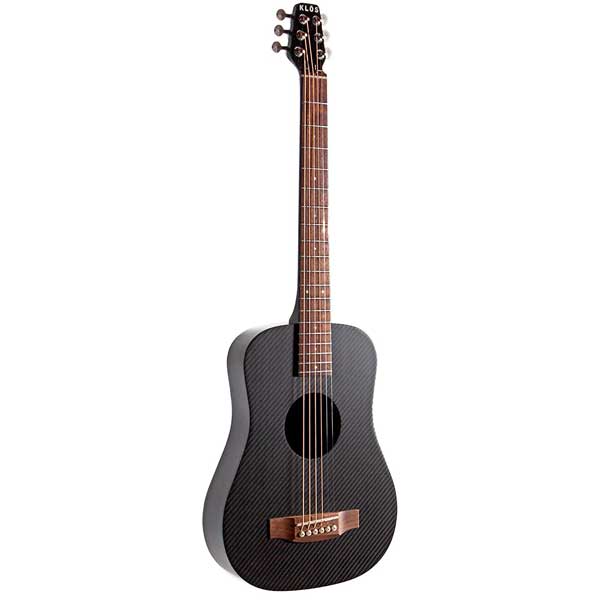
| Estimated Price | $770 |
| Body Type | Travel |
| Topwood Material | Carbon Fiber |
| Back and Sides Material | Carbon Fiber |
| Neck Material | Mahogany |
| Fretboard Material | Brazillian Cherry |
| Color | Black |
| Number of Strings | 6 |
My Review: The KLOS Black Carbon Fiber Travel Acoustic Guitar brings a new and innovative model to the musical world. Its carbon fiber material makes it one more durable and longer-lasting than any wood acoustic. There’s no need to humidify this wonderful instrument. Additionally, this guitar can survive any weather conditions as it has literally traveled all over the world including some of the highest mountains on the planet! You may ask yourself, “But what about the sound?” This travel acoustic not only ensures longevity, but also a sound that matches, if not exceeds, the quality of sound produced by any top wood. The carbon fiber helps produce a rich and vibrant sound that will carry in any room (or on any mountain for that matter). Anyone beginner or experienced guitar player looking to try something new should seriously consider this model.
Key Specs and Features: The body of this acoustic has a nifty travel shape that is compact and has square shoulders. Similar to a classic dreadnought, however, the length is slightly shorter and the width is slightly narrower. The carbon fiber material allows this guitar to endure the most extreme weather conditions and never warp or break over time. Though it has a smaller body, it has a full-scale length allowing players to easily play along the smooth, Brazillian cherry fretboard. The mahogany neck will comfortably sit in the palm of your hand as you move from chord to chord. Most interesting to the design of this guitar is the detachable neck. It’s as simple as removing four screws and you can safely isolate the neck away from the body. These guitars are known for their portability. You will take up nearly half the amount of space as you would normally carrying your guitar around. Provided to you as well as the zero degrees minimalistic headstock that includes its very own truss rod, used to restring your guitar. The accessories included with this product include a gig bag, strap, capo, rain cover, screwdriver, and a truss-rod wrench.
Who Will Use the Most: For any beginner or experienced guitarist invested in their craft and wanting to try something new, this may be the guitar for you. Its unique carbon fiber material makes it stand out from other guitars and it does not sacrifice its sound in any way. This guitar will also suit the “outdoorsy” type who enjoy spending their time in nature. Because of this guitar’s durability and portability, it will make the ideal instrument to bring on a camping trip.
The Bottom Line: The bottom line is that this is a reasonably priced guitar that brings something new to the table. If you’re on a budget, but want to tread into unfamiliar territory, then consider this marvelous instrument.
11. Taylor GS Mini-e Limited Black Limba ESB Acoustic-Electric Guitar
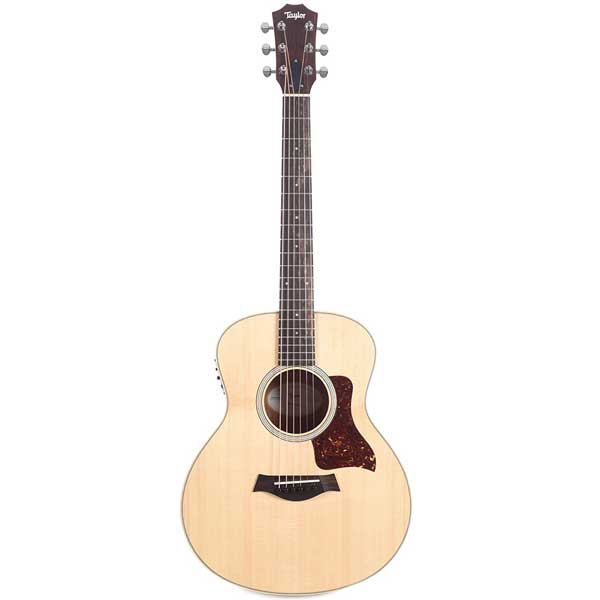
| Estimated Price | $750 |
| Body Type | Miniature Grand Symphony |
| Topwood Material | Sitka Spruce |
| Back and Sides Material | Layered Black Limba |
| Neck Material | Maple |
| Fretboard Material | Ebony |
| Color | Natural |
| Number of Strings | 6 |
My Review: The Taylor GS Mini-e Limited Black Limba ESB delivers a large sound in a compact design. With a scale length of 23-½ inches, this small scale guitar keeps a resonant sound because of classic spruce top wood and black limba back and sides. Built-in electronics give players versatility, allowing you to play acoustically or plug into an amplifier. The color of this guitar comes in a vibrant “Natural”. This product also comes with its very own gig bag, which makes traveling a piece of cake. Anyone invested in upgrading their guitar should absolutely consider this guitar.
Key Specs and Features: With a rich and robust tone, the Grand Symphony body style will provide a broad dynamic range and the capability to fill any room with its sound. The body is made from black limba on the back and sides, while the top wood is a standard Sitka spruce. This gives the guitar a crisp sound further clarifying the articulation and dynamics as you play. The fretboard delivers a smooth and playable experience because of its ebony tonewood. This lightweight, compact instrument will serve you well on the go, especially with the included gig bag. This accessory protects your guitar from any potential damage incurred while going from gig to gig.
Who Will Use the Most: Experienced guitar players looking to upgrade their instrument should definitely consider this guitar. This is especially true if you enjoy smaller guitars and like the feel of a Mini Grand Symphony.
The Bottom Line: The bottom line is that this is a high-value, high-impact guitar. You receive an excellent sound for a reasonable price.
Related Popular Article: Review of our 17 Favorite Acoustic Guitars Under $500
12. Fender CD-60S 6 String Acoustic-Electric Guitar
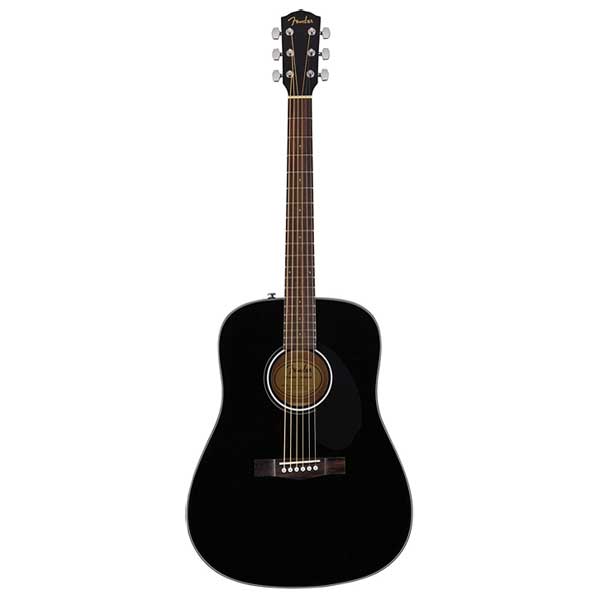
| Estimated Price | $230 |
| Body Type | 6.6 pounds |
| Topwood Material | 48 x19.5 x 8.7 inches |
| Back and Sides Material | Mahogany |
| Neck Material | Morado |
| Fretboard Material | Natural |
| Color | Phosphor Bronze |
| Number of Strings | 6 |
My Review: The Fender 6 String Acoustic-Electric Guitar delivers a quality sound as a result of its exquisite tonewoods and superior design. As part of the Fender California Series, this marvelous line of guitars pays homage to the California lifestyle that’s described as colorful, lively, and independent. While providing a rich, resonant tone that compares to any high-quality guitar, this model uniquely includes an acoustic-electric option. This allows players to amplify their sound while retaining all of the beautiful acoustic qualities. The rustic look as a result of the solid mahogany top wood will make you want to pack your things and head for the beach. For anyone searching for high-quality without spending an absurd amount of money, this guitar may suit you the best.
Key Specs and Features: The Fender-exclusive Newporter body shape provides a deep, resonant tone that will carry throughout the room as you play. Solid mahogany covers both the top and back and sides of the guitar, which produces a flourishing high range. The tonewood also makes it very aesthetically pleasing to view. Remember to utilize the guitar’s cutaway, which allows players to reach a higher range on the fretboard. The neck is also made of mahogany and supplies a smooth, C-shaped profile that will easily lay in the palm of your hand. The Morado fretboard and bridge give players simple mobility for fast playing going from one fret to another. The tilt-back headstock has a 6-in-line setup for its tuners. Because this is also an acoustic-electric guitar, this model comes with its very own Fender-exclusive Fishman pickup/preamp system. This gives your tone a boost of sound when plugging it into an amplifier. Finally, freely and safely with the provided deluxe gig bag.
Who Will Use the Most: For experienced guitar players looking for a significant upgrade, this may be the guitar for you. This is especially true if you want to upgrade to an acoustic-electric guitar.
The Bottom Line: Quality of build and sound, pleasing aesthetics, and integrated preamp, you will be investing in a high-quality guitar. Additionally, compared to other guitars at this price, you are getting one sweet deal.
13. Taylor Academy 12e-N Grand Concert Nylon Acoustic Guitar Natural
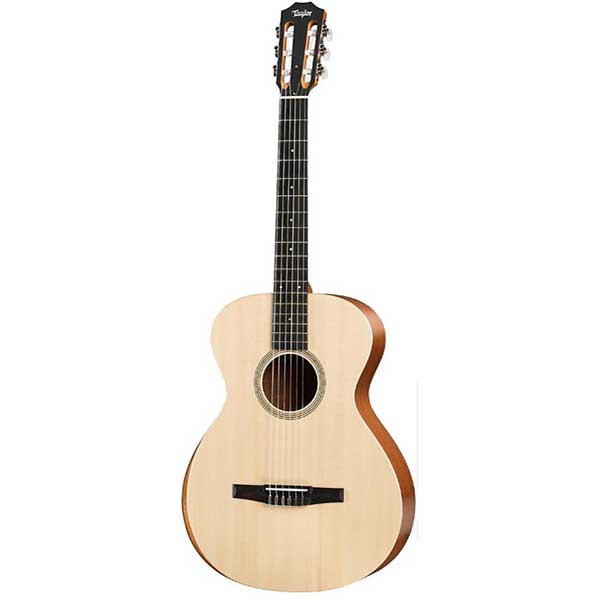
| Estimated Price | $700 |
| Body Type | 8 pounds |
| Topwood Material | 19 x 8 x 45 inches |
| Back and Sides Material | Layered Sapele |
| Neck Material | Layered Sapele |
| Fretboard Material | Natural |
| Color | Nylon |
| Number of Strings | 6 |
My Review: The Taylor Academy Series Academy 12e-N Grand Concert Nylon Acoustic Guitar delivers a high-quality product for any entry-level guitar player. For any beginning guitar player, the logic usually goes that you should start out by playing with a cheap guitar and upgrade once you’re more comfortable with playing altogether. Unfortunately, more often than not, this leads to deep frustration with the instrument and many decide to quit before they even get to this point. The mission of the Taylor Academy series is to spark a drive for playing right away because of the guitar’s playability. Beginning with this higher quality guitar will ensure a passion for playing and an immediate connection to the world of guitar. This gorgeous design comes in vibrant natural color.
Key Specs and Features: The Grand Concert body style will sit comfortably in your lap as you play. This is accompanied by smooth and layered Sapele back and sides. Its long scale length at 25.5 inches allows players plenty of room to move along the fretboard, especially when it comes to soloing. For anyone just getting started, you will appreciate the lightweight design (8 pounds) of this guitar considering that you will likely travel to many gigs without the burden of a heavy instrument.
Who Will Use the Most: This guitar serves beginners looking to play on a high-quality instrument right away. For players invested in playing often and gigging locally, this may be an appropriate guitar for you.
The Bottom Line: You can’t beat the value and quality of this model if you are looking specifically for a nylon string classical style guitar.
14. Martin Dreadnought Junior Acoustic Guitar
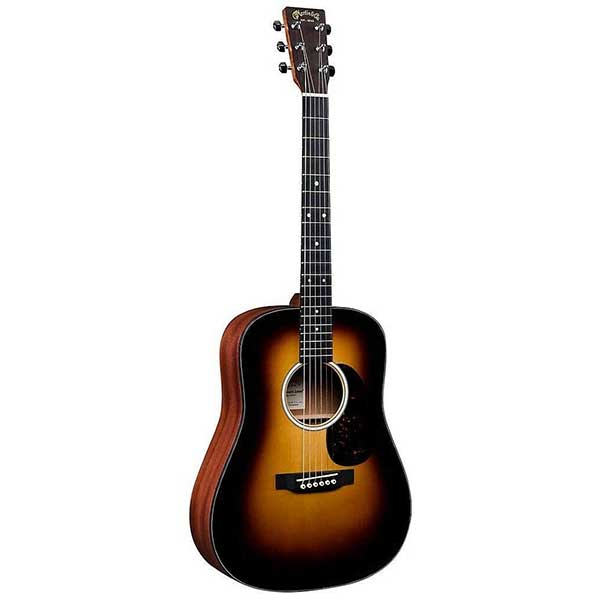
| Estimated Price | $500 |
| Body Type | Dreadnought |
| Topwood Material | Spruce Wood |
| Back and Sides Material | Sapele |
| Neck Material | – |
| Fretboard Material | Natural Spruce |
| Color | Natural |
| Number of Strings | 6 |
My Review: The Martin Dreadnought Junior Acoustic Guitar is another rare combination of a small instrument that can still produce a professional sound. The price reflects the quality, and it is fair considering the features offered.
Key Specs and Features: The dreadnought body without a cutaway provides a deep, warm resonance. This is a smaller body and classified as a “D Junior.” The top wood is made of Sitka Spruce and accompanied by Sapele for the back and sides, still maintaining a big sound considering its size. The smooth, satin finish will provide comfort while playing sitting down or standing up with a strap. The dreadnought junior neck shape with its High-Performance Taper allows players to move fluidly from fret to fret. This is “fast neck” with a scale length of 24″. It is made of solid hardwood, the fingerboard made of FSC Certified Richlite. The neck is also touched up with a rich satin finish. Similar to its fingerboard, the bridge is made of FSC Certified Richlite. The materials of the saddle and nut are built from compensated white tusq and white Corian. The guitar’s chrome enclosed gold gear that ensures easy tuning. This model does not have its own preamp.
Who Will Use the Most: The Martin Dreadnought Junior Acoustic Guitar is for players who believe in you get what you pay for. It is a professional level guitar, and the simple design will attract first-time players or traveling musicians who are looking for a second acoustic to practice or perform on.
The Bottom Line: The Martin Dreadnought Junior packs incredible quality, tone, and versatility.
15. Taylor GS Mini Mahogany

| Estimated Price | $500 |
| Body Type | GS Mini |
| Topwood Material | Mahogany Sapele |
| Back and Sides Material | Sapele |
| Neck Material | Sapele |
| Fretboard Material | Ebony |
| Color | Natural |
| Number of Strings | 6 |
My Review: Taylor is well-known for producing some of the highest quality acoustic guitars on the planet, and the Taylor GS Mini is no exception. Many players who purchase the Taylor GS Mini do so based on that reputation and for its portability, but there are plenty of other reasons to love this guitar. Don’t let the “miniature” label make you think you are going to compromise on sound. This lightweight beauty is quality through and through, and we were surprised at the big sound from this guitar.
Key Specs and Features: The top is constructed entirely from solid Mahogany, and the back and sides are made from Sapele. The combination of the two results in an aesthetically awesome-looking guitar with deep, resonant sound and full projection. Taylor layers the wood, which gives it a much warmer tone. Taylor GS mini-profile neck is constructed from Sapele wood. The 20-fret fretboard is made of rare African Ebony and is 23.5″ in length. The playability of the neck has no fret buzz sound and is smooth with comfortable action. The action is intentionally set low to suit more experienced players but is also adjustable. Like the fretboard, the bridge is also built from genuine African ebony. The headstock overlay is Sapele wood covered with Lexan for durability. The tuner is a Chrome GS Mini with chrome buttons.
Who Will Use the Most: The Taylor GS Mini is a great fit for new and experienced guitar players who want a long-lasting instrument that is portable, professional, and doesn’t compromise on sound. The only accessory offered with this guitar is the GS Mini Hard Bag, but it is a quality gig bag that should not be underestimated.
The Bottom Line: The Taylor GS Mini acoustic guitar is a pro-series beginner guitar for players who appreciate the attention to detail and quality and want a small guitar with a big sound.
16. Martin LX1E Little Martin
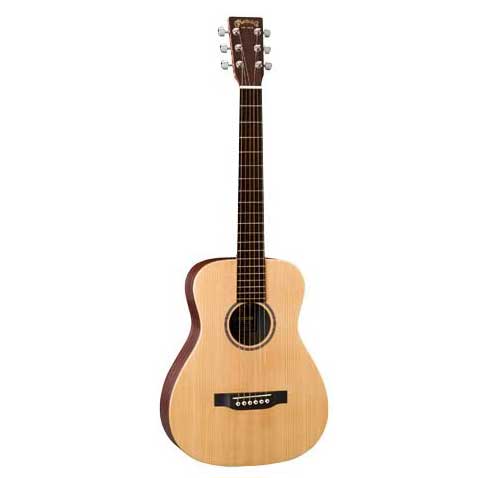
| Estimated Price | $450 |
| Body Type | Dreadnought |
| Topwood Material | Solid Sitka Spruce |
| Back and Sides Material | Mahogany Pattern HPL textured finish |
| Neck Material | Nato |
| Fretboard Material | Morado |
| Color | Natural |
| Number of Strings | 6 |
My Review: The Martin LX1E Little Martin is the electric-acoustic version of the Martin LX1 (the “E” is for “electric”). Don’t be deceived by its small size; this guitar packs a punch with its superb tone and aesthetically pleasing look. With a standard Sitka spruce top wood and a warm satin finish, it’s no wonder why this is one of the most popular guitar models on the market. If you’re looking for a quality sound, invested in practicing and performing regularly, this is the guitar for you.
Key Specs and Features: The naturally modified 0-14 fret body with a non-cutaway body style is the same for both the acoustic and acoustic-electric versions of this guitar. They both feature a solid Sitka Spruce top, hand-rubbed finish, and a laminate with a Mahogany pattern. The neck is a medium-low oval shape made of Rust Birch laminate. This means you get the same beginner-friendly grasp with exceptional durability. The nut material is a solid Corian, and the neck joint is mortise/tenon. The Martin LX1E Little Martin is the electric version of the acoustic model, but the two models differ in other ways as well. The sound of the LX1E is certainly a matured and “big” sound in comparison, which has as much to do with its construction as it does the Fishman Sonitone pickup. The LX1E is considered a beginner’s guitar, but the color and variety of tones it is capable of will attract even seasoned professionals.
Who Will Use the Most: This guitar is for beginners of all ages, entertainers, or students. It’s also great for those who travel and comes with a gig bag.
The Bottom Line: The LX1E is a perfect choice for players who want a small guitar with a big sound, or who like to travel but hate leaving their guitar at home.
17. Yamaha CSF1M
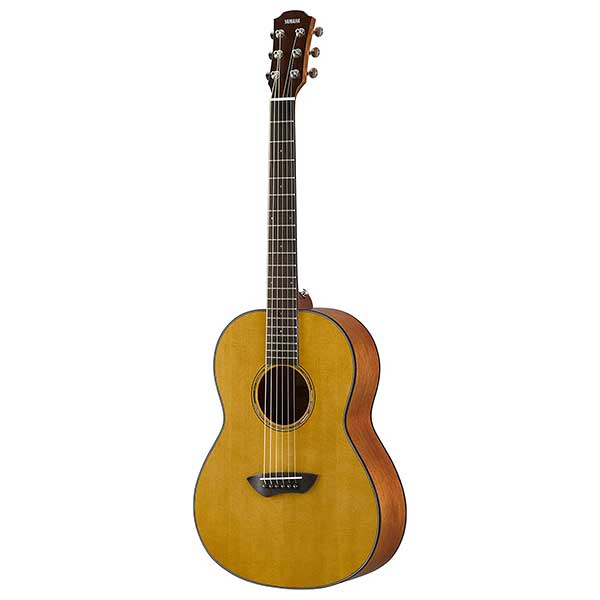
| Estimated Price | $430 |
| Body Type | CSF |
| Topwood Material | Solid Sitka Spruce |
| Back and Sides Material | Mahogany |
| Neck Material | Nato |
| Fretboard Material | Rosewood |
| Color | Natural |
| Number of Strings | 6 |
My Review: The Yamaha CSF1M features a Folk-style body (no cutaway) and a compact size. It has an exceptional overall sound for a relatively low price.
Key Specs and Features: The top wood is solid Sitka Spruce while the back and sides are constructed of laminated Mahogany. This makes for a warm and well-balanced tone, especially for a smaller guitar. The CSF1M is a step up from some of the other classic, less expensive Yamaha parlor guitars that come in either Tobacco Brown Sunburst (costs extra) or a natural finish. The white and black body binding is set off with a simple abalone rosette, and the sides are broader than some other Yamaha models. That size difference gives this instrument an impressive full-bodied sound.
With a length of 23.6″, it is smaller than many other parlor guitars, and reviews from players who have purchased this guitar comment on how that slight change in length makes a noticeable difference in its ability to be held comfortably by smaller players. The neck is solid nato with a 20-fret rosewood fretboard. The comfortable C-shaped profile makes it enjoyable to hold and play. The playability is satisfactory out of the box. However, depending on your needs, this one might benefit from a professional setup after purchase. The CSF1M has no preamp panel on the side bout, and you might not even notice the electronics which are hidden quite well in the soundhole. The pickup is a passive SRT Zero-Impact piezo model and is a great addition. The CSF1M has a unique offset design with a solid rosewood bridge. As expected from most Yamaha’s of this quality, the die-cast chrome, closed-gear tuning machines are reliable and precise.
Who Will Use the Most: Relatively new on the market, this guitar has become a popular go-to parlor guitar for many satisfied players. For both beginners and those who travel with their guitars, this is also an excellent choice.
The Bottom Line: The CSF1M is a unique, quality parlor guitar with exceptional extras at a great value.
Choosing the Right Acoustic Guitar (Buying Guide)
Knowing what to look for in an acoustic guitar can often be overwhelming. Components such as the body, strings, and size of the guitar all influence your playing experience. Two of the most important things to consider when selecting a guitar are its quality of sound and playability. It may seem obvious that these qualities would absolutely affect the experience playing in the moment, but also consider their influence on incentivizing practice. In the beginning, consistently practicing can get frustrating and annoying, especially when you haven’t learned any songs yet.
As mentioned before, selecting an acoustic guitar may become frustrating. Where in the world do you begin? There’s no need to fret (yes, pun intended). This article will guide you through the characteristics worth knowing about your future acoustic. The article begins with a buying guide that breaks down these characteristics and defines their importance for your goals as a musician. Then, there will be a series of product reviews of acoustic guitars that are high-value, affordable choices easily accessible to buy online. Whether you desire to play guitar to become a professional, or simply to entertain your friends, you are one step closer to that realizing that dream. Knowing what to look for in an acoustic guitar can often be overwhelming. Components such as the body, strings, and size of the guitar all influence your playing experience. Two of the most important things to consider when selecting a guitar are its quality of sound and playability. It may seem obvious that these qualities would absolutely affect the experience playing in the moment, but also consider their influence on incentivizing practice. In the beginning, consistently practicing can get frustrating and annoying, especially when you haven’t learned any songs yet. Don’t you want a guitar that is comfortable to play and easy to hold? Any additional discomfort from the guitar may lead to giving up playing altogether. To deter this from happening, doing a little research about the guitar you decide to buy will likely lead to both a better playing experience and longevity to playing itself.
As mentioned before, selecting an acoustic guitar may become frustrating. Where in the world do you begin? There’s no need to fret (yes, pun intended). This article will guide you through the characteristics worth knowing about your future acoustic. The article begins with a buying guide that breaks down these characteristics and defines their importance for your goals as a musician. Then, there will be a series of product reviews of acoustic guitars that are high-value, affordable choices easily accessible to buy online. Whether you desire to play guitar to become a professional, or simply to entertain your friends, you are one step closer to that realizing that dream.
When it comes to buying an acoustic guitar, there are many things you should consider. The first being why you want to play guitar in the first place. Are you looking to regularly gig and perform in your community? Or are you simply exploring your musical side and desire to play at home? No matter your purpose, understanding your musical goals will help you identify what kind of guitar you should buy. To begin with, it’s important to have a grasp on basic acoustic guitar anatomy.
Body Shapes Explained
The body of your guitar will heavily influence your sound and comfortability while playing. This part of the guitar is broken down into several sections. First is the top, otherwise known as the soundboard. Sometimes the wood on the soundboard will differ from the other sections that support it, such as the back, internal bracing, and sides. This construction also contains its own soundhole placed in the center and leads into the hollowed chamber inside of the body.
Sometimes the soundhole is protected with a pickguard made from plastic in order to prevent any damage and consequently, an undesired change in the sound.
The sides of the body can also be broken down into a couple of sections. The curved sides closest to the neck are called the upper bouts, whereas the curved sides furthest away and towards the bottom of the guitar are called the lower bouts. The area between these two sections, and the more significant part of the body, is called the waist. These sections become very important in appropriately sizing the guitar, especially for beginners that need to find a comfortable fit. A basic sizing chart recommends that kids ages 5-7 should play on a half-size guitar, 7-10 on a three-quarter-size, and 11 and up on a full-size.
As much of the guitar’s size and feel is important, finding the right shape as it relates to sound is equally so. As a general rule, the bigger the body, the deeper and richer the sound will be. The following body shape examples will give you further insight into the particular qualities that each provides.
Dreadnought
The dreadnought body type is arguably the most popular guitar body on the market. With an enormous soundboard and deep hollow chamber, this shape is known for its big, driving sound versatile for many music genres. The Martin Company first produced the dreadnought style in 1916 and, as a result, commodified one of the most recognizable guitar models in the world. Its most distinctive features include their square bouts, wide waists, and 14-fret necks (that is, 14 frets above the body).
Adjusting to the big and bold feel of the dreadnought style can be difficult at first. With a little practice and time, you will reap the benefits of a rich, colorful sound that fits everywhere from campfire songs to a bluegrass band. As mentioned, although it may seem larger, there are age-appropriate sizes that still maintain the resonant sound of a dreadnought body.
Round-shoulder Dreadnought
As you might expect based on the name, the primary difference between this model and a typical Dreadnought is the shape of the guitar’s shoulders. Providing a smooth, more rounded figure of the body near the bottom of the neck helps facilitate a warmer, more balanced tone. Otherwise, this model remains as versatile as a standard Dreadnought, being able to play everything from country to folk.
Jumbo
Known as the “cowboy’s guitar,” the Jumbo body provides a deep, resonant sound as you play the blues or sing a lonesome country song. Around 17″, the length of the lower bouts are significantly longer than the upper bouts. The difference between these two lengths also shortens the waist making a “tighter” feel when playing sitting down. Adjusting to its larger size may take a little longer, but its deep, “bass-y” quality will make the wait worthwhile.
Auditorium
Emerging as a popular body style over the last few decades, the Auditorium guitar shape provides a deep, resonant tone similar to the classic dreadnought. This mid-sized guitar has a comparable width to the dreadnought; however, its waist is slightly skinnier. The Auditorium works perfectly for any player looking to perform at home or on small stages. Its spacious, hollow inside delivers a pleasant sound, appropriate for an intimate concert with friends.
Grand Auditorium
Like the Auditorium Acoustic, this guitar shape maintains a deep, luscious tone, though it’s even more resonant. This guitar has a wider lower bout, usually around 16″, but also provides a curvier shape due to its drastically skinny waist. If you want a sound that can carry further than the Auditorium, then you may want to upgrade to the Grand Auditorium.
Concert and Grand Concert
For players looking for an instrument that is sized a little smaller, a Concert or Grand Concert may suit your needs. A Concert has a lower bout around 13-½,” and a Grand Concert has a slightly larger lower bout around 14-½”. In terms of tone quality, the Concert delivers a brighter sound that accentuates its mid-range. Similarly, the Grand Concert has an exquisite mid-range but additionally gives you a more extensive range for volume. Much of these differences are best discovered by going to a music store and playing both.
Travel and Mini-Acoustics
If you are looking for a guitar on a budget and want one just for the sake of playing, consider Travel and Mini-Acoustics. These are generally made for kids due to their small, durable, and convenient design. Though you may worry you’re sacrificing good tone for a reasonable price, this is not the case among many guitar manufacturers. Some guitar manufacturers focus on delivering an excellent product that scales the size down, but not tone quality.
Referred to sometimes as “backpackers,” the Mini-Acoustics often get sized to a standard guitar. However, in order to provide an easily transportable product, manufacturers make the width more narrow, fanning slightly from the width to the neck. Additionally, these models contain
18-20 frets and are scaled about ¾ the size.
Parlor
With a rich history spanning from the early 20th century to the 1950s (though having a resurgence in popularity during the 21st century), Parlour guitars function as a smaller alternative to larger guitar body models. With a smaller round bout and thinner width to the overall body, this guitar merges portability and playability without sacrificing tone quality.
Neck Considerations
The neck of the guitar connects to the body and includes a back, fretboard, and a headstock. A neck is usually attached to the body with glue, which is also known as a “set neck.” Sometimes, however, acoustic guitars will be bolted on to the body. This is less common, and manufacturers make electric guitars in this way.
Known as the “fretboard,” the top layer of wood contains small metal strips that divide the area into many spaces that indicate different musical notes. Where you press down on the strings determines which notes will be heard. There are twelve musical notes playable on the fretboard, and you shift one note when shifting one fret. For example, if you play a B and shift one fret
closer to the body (provided that you did not change strings), you will have moved to create3 the sound for the pitch of “C.” Common fretboard woods include ebony and rosewood.
The headstock is the wooden square furthest from the body and contains six tuners that allow players to modify the pitch of each individual string. These pegs are made of metal and loosen/tighten the tension depending on which way you turn it. Additionally, at the bottom of every headstock (right above the top of the neck), there is a white strip known as the “nut.” Functionally, the nut stabilizes the strings with grooves that deter any unwanted movement. Nuts are made from either plastic or bone.
There are three most common shapes on the back of the neck, often referred to as the “neck profile”: C-shaped, U-shaped, and V-shaped. Most players today have a C-shaped neck profile characterized by a smooth, oval shape shallower than Us and Vs. U-shapes, sometimes referred to as “baseball bat” necks, are slightly deeper and thicker than C-shaped necks. They come with higher shoulders and work best for players who have larger hands. Finally, V-shaped necks come in two different styles. There’s the “soft” V that’s more rounded, and the “hard” V has a more pointed shape. Players will seek out the “hard” V shape if they prefer to have their thumb hang over the fretboard as they play. As you can see, there are many different options for neck shapes. For beginners, selecting a C-shaped neck will likely be the most comfortable and easiest way to get used to playing.
Getting the right size neck becomes important, especially if you are just starting out on the guitar. You should know the width and length of a guitar neck before purchasing. Guitars will often be labeled as a 12, 13, or 14-fret guitar, which can also help in making your decision regarding the size. To be clear, this does not mean the number of frets total, but rather the number of frets on the neck. A couple of frets extend on to the body of the guitar. If you have smaller hands and do not desire constantly stretching for notes, consider getting a 12-fret guitar.
Acoustic vs. Acoustic-Electric
You may have seen certain types of acoustic guitars labeled as “acoustic-electric.” What are these, and how do they differ from a traditional acoustic? There is no discernable difference between the sound of an acoustic guitar and an acoustic-electric guitar in terms of their sound. The only difference lies in the acoustic-electric’s ability to plug into an amplifier. Basically, an acoustic-electric guitar contains a pickup system that converts the vibrations from the guitar into an electrical signal that translates through an amplification system. Thus, your acoustic becomes electric. Sometimes, however, this electrical signal is not very strong, so some players will use a preamp for more power. Acoustic-electric guitars also may include features such as volume, treble, bass, and maybe a built-in tuner.
Sometimes acoustic guitar players invest in what’s known as a magnetic pickup that manually attaches to your soundhole. These sense magnetic vibrations as you play and translate the information into electrical signaling. Unfortunately, this does not work with nylon strings, and the sound can be far removed from what your acoustic actually sounds like. Nonetheless, this can be an excellent option for someone looking to amplify their sound while on a budget!
Influence on Sound
There are many factors that will influence the sound of your guitar. Everything from the size of the body to the type of wood used will, in some way, change the way the strings vibrate and resonate out of the soundhole. Here are a couple of influencers for you to consider.
Cutaways
A guitar cutaway is an indentation on the upper bout of the body that allows players to play frets up the neck more easily. Players that are used to playing on an electric or would like to play lead on an acoustic would benefit the most from having a cutaway. Additionally, this feature will not profoundly affect your sound by design; however, provided you play more solos, a cutaway expands your playing demands immensely.
Tops
Similar to how the type of wood on the top of the body will affect the sound of the guitar, the finish of that wood also influences it. Of course, the top has the most significant impact on the guitar’s overall sound, considering that it is also where the soundhole resides. This debate generally centers around differences between a solid finish and a laminate finish. A solid top uses two single-ply pieces of wood with matching grains down the middle of the guitar top. This delivers a vibrant, deeply resonant tone that supersedes any competition from laminate. A laminate finish has many kinds of wood all pressed together with the highest quality wood on top. Though the sound of the laminate may not compare to a solid top, players looking for a guitar on a budget may appreciate its superior sound quality for the price.
Strings
There are two primary kinds of strings that guitar players use: nylon and steel strings. Debating which strings are better to use when beginning guitar often becomes about playability. But truthfully, it has way more to do with what kind of music you would like to play. Nylon strings
will be easier to play at first, but you should consider them for other reasons as well. They have a softer, mellower sound appropriate for styles such as flamenco, classical, and folk. If you want a brighter, punchier tone, then go with steel strings. Steel strings are often associated with genres such as pop, rock, and country. However, it’s worth noting that if you begin with steel strings, it will make playing slightly more difficult, but don’t let that stop you if you desire to play any of the genres above.
Tonewoods Explained
Of course, your new acoustic guitar will be made from a couple of different woods. But how does this wood affect your playing experience? Well, the wood on the top, as well as the back and sides, heavily influence the quality of the guitar’s tone. Considering that there are so many types of wood used, navigating which ones suit your needs can often be tricky. Below is a list of common tonewoods and the tonal characteristics they exhibit.
Cedar: Most commonly used for classical or flamenco-style playing; a softwood that delivers a brighter, more vibrant sound.
Cocobolo: Used primarily for the back and sides; a Mexican softwood providing a bright tone.
Ebony: Commonly used for the fretboard; smooth and allows for movement up and down the neck.
Granadillo: Produces a crisp tone and often used on the back and sides; a specific type of rosewood.
Koa: Is a luxury Hawaiian wood that is less commonly used, but produces a gorgeous midrange; used both for the top and back and sides.
Mahogany: Known as a top wood for country music and blues; a dense tonewood that flourishes when playing in a higher range.
Maple: This tree is not only known for its delicious syrup! It is used on the back and sides and creates a “dry” sound; it is versatile by accentuating high notes while also providing a lower resonance that cuts through for live performances.
Ovangkol: African tonewood that produces an exquisite midrange; similar to rosewood, it’s most commonly used for the backs and sides.
Rosewood: Traditional rosewood (Brazilian) over the years has become replaced with Indian rosewood, yet they sound virtually identical; known for its rich, resonant tone, especially during a “bass-heavy” section; used for back and sides as well as the fretboard.
Sapele: African wood similar to Mahogany; provides excellent midrange and treble tones,
Spruce: Is a very clear, crisp top wood and is often known as the standard top wood for many guitar players; various types of Spruce slightly influence the tonal palette, including Sitka, Adirondack, and Engelmann.
Walnut: A unique replacement for a mahogany body; a dense tonewood that bolsters midrange and provides a sound that carries far and with resonance.
Accessories
Accessories are the last thing you should consider when buying an acoustic guitar, but nonetheless are essential. There are many guitars online that will supply a wide variety of accessories with the purchase of your new guitar, which can be exciting for new players. Here are a couple of accessories that will immensely improve your experience as you learn how to play.
Picks
Guitar picks are flat, plastic strumming devices that allow you to pluck the strings of your guitar. Though certain types of guitar playing require you to use your fingers, a pick gives you the ability to play scales and chords with vibrancy from the very start. The shape and thickness of your pick will also influence your strumming tone.
A standard guitar pick is shaped like an isosceles triangle with two of the corners rounded. This is sometimes referred to as the “tortoiseshell.” Other shapes do exist, but the purpose of the
non-rounded corner is to deliver the standard brightness you hear from many guitar players. Playing with your fingers will create a warmer, mellower tone. Going further, the more point the corner of the pick is, the brighter the sound will become.
The thickness of the pick also influences how “dark” your tone will be. Picks come in a variety of thicknesses, but as a general rule (and a fun tongue-twister), the thicker the pick, the deeper the tone. Try saying that ten times fast!
Electric Tuners
Your acoustic naturally supplies six tuning pegs on the headstock, allowing you to change each string’s pitch. But how do you know that each string is tuned to their respective and standardized notes? As you play, an electric tuner displays where the note lies in relation to the correct,
in-tune frequency to be in tune. It will tell you whether you’re sharp, flat, or right on the money.
There are a couple of different types of electric tuners. Sometimes, guitar kits come with clip-on tuners that go right on your headstock. Acoustic-electric guitars nowadays often come with their own built-in tuner for players to use. This being said, in recent years, the tuning hardware is becoming less relevant as many apps on your phone possess the exact same capabilities.
Straps
Straps give you more mobility as a player. Though you may often play sitting down, there may be times when you’re performing and would like to be standing up. A guitar strap alleviates any unwanted shoulder pain or stress of dropping the instrument. Two important factors when choosing a guitar strap are length and material.
Choosing the right length is vital for using the guitar strap altogether. Sometimes players prefer playing high and tight, where others like the guitar to hang low and away from their chest. The best advice is to buy an adjustable strap that gives you the option to position your guitar in a variety of locations.
The material of the strap is also important as it relates to comfortability and style. There are many different materials used, but the most common include polyester, nylon, leather, suede, vinyl, or velvet. For someone just beginning to play guitar, nylon or polyester strap will work best due to its lightweight nature.
Extra Strings
This one is a given, but making sure you have extra strings becomes important when your old strings wear out or break. As a general rule, many guitar players recommend replacing your strings every three months or 100 logged hours of playing. You don’t want to be in the middle of a performance when suddenly you look at your fretboard only to find five strings!
Gig Bag
For the traveling musician (and any musician at all for that matter), consider investing in a quality gig bag. Gig bags are lightweight, soft-padded cases that minimize potential damage to your guitar while storing it or transporting it to gigs. Depending on the type you buy, many come with compartments to hold your accessories. These bags make it simple and easy to carry a guitar, which otherwise is a pretty clunky thing to lug around.
Wrap Up:
That does it for this review. Leave a comment below to let us and everyone else know what you think is the best acoustic electric guitar under 1000 dollars below. Also, feel free to leave questions below and we will get back to you as soon as possible.

My name is Chris and I’ve had a passion for music and guitars for as long as I can remember. I started this website with some of my friends who are musicians, music teachers, gear heads, and music enthusiasts so we could provide high-quality guitar and music-related content.
I’ve been playing guitar since I was 13 years old and am an avid collector. Amps, pedals, guitars, bass, drums, microphones, studio, and recording gear, I love it all.
I was born and raised in Western Pennsylvania. My background is in Electrical Engineering, earning a Bachelor’s degree from Youngstown State University. With my engineering experience, I’ve developed as a designer of guitar amplifiers and effects. A true passion of mine, I’ve designed, built, and repaired a wide range of guitar amps and electronics. Here at the Guitar Lobby, our aim is to share our passion for Music and gear with the rest of the music community.
